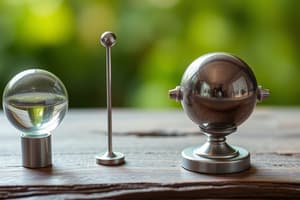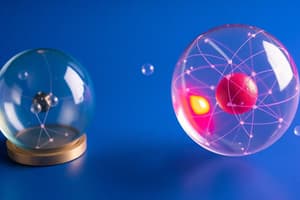Podcast
Questions and Answers
What does physics primarily study?
What does physics primarily study?
- Matter, energy, and their interactions (correct)
- The formation of geological features
- The composition of stars
- The structure of living organisms
Which branch of physics deals with the motion of objects and the forces that cause them?
Which branch of physics deals with the motion of objects and the forces that cause them?
- Thermodynamics
- Optics
- Mechanics (correct)
- Electromagnetism
Which of Newton's Laws states that an object in motion stays in motion unless acted upon by a force?
Which of Newton's Laws states that an object in motion stays in motion unless acted upon by a force?
- First Law (correct)
- Third Law
- Second Law
- Law of Gravitation
What is the formula for kinetic energy?
What is the formula for kinetic energy?
Which of the following is a measure of the average kinetic energy of atoms in a system?
Which of the following is a measure of the average kinetic energy of atoms in a system?
Which law of thermodynamics states that the entropy of an isolated system always increases or remains constant?
Which law of thermodynamics states that the entropy of an isolated system always increases or remains constant?
What is the transfer of energy due to a temperature difference called?
What is the transfer of energy due to a temperature difference called?
Which of the following is a fundamental property of matter that causes it to experience force in an electromagnetic field?
Which of the following is a fundamental property of matter that causes it to experience force in an electromagnetic field?
What is the rate of flow of electric charge called?
What is the rate of flow of electric charge called?
What is the region around a charged object where a force would be exerted on other charged objects?
What is the region around a charged object where a force would be exerted on other charged objects?
What is the change in direction of a wave as it passes from one medium to another called?
What is the change in direction of a wave as it passes from one medium to another called?
What is the bending of waves around obstacles or through apertures called?
What is the bending of waves around obstacles or through apertures called?
Devices that focus or disperse light through refraction are called what?
Devices that focus or disperse light through refraction are called what?
In quantum mechanics, what is the smallest unit of any physical property called?
In quantum mechanics, what is the smallest unit of any physical property called?
What principle states that it's impossible to know both the position and momentum of a particle with perfect accuracy?
What principle states that it's impossible to know both the position and momentum of a particle with perfect accuracy?
What is the study of light and its behavior called?
What is the study of light and its behavior called?
Which of the following deals with heat and its relation to other forms of energy?
Which of the following deals with heat and its relation to other forms of energy?
Which branch of physics describes the motion of objects without considering the forces that cause the motion?
Which branch of physics describes the motion of objects without considering the forces that cause the motion?
What type of energy is possessed by an object due to its position or condition?
What type of energy is possessed by an object due to its position or condition?
Which of the following involves the production of an electromotive force across an electrical conductor in a changing magnetic field?
Which of the following involves the production of an electromotive force across an electrical conductor in a changing magnetic field?
Flashcards
What is Physics?
What is Physics?
The study of matter, energy, and their interactions.
What is Mechanics?
What is Mechanics?
Deals with the motion of objects and the forces that cause that motion.
What is Thermodynamics?
What is Thermodynamics?
Deals with heat and its relation to other forms of energy.
What is Electromagnetism?
What is Electromagnetism?
Signup and view all the flashcards
What is Optics?
What is Optics?
Signup and view all the flashcards
What is Quantum Mechanics?
What is Quantum Mechanics?
Signup and view all the flashcards
What is Kinematics?
What is Kinematics?
Signup and view all the flashcards
What is Dynamics?
What is Dynamics?
Signup and view all the flashcards
Newton's First Law
Newton's First Law
Signup and view all the flashcards
Newton's Second Law
Newton's Second Law
Signup and view all the flashcards
Newton's Third Law
Newton's Third Law
Signup and view all the flashcards
What is Work?
What is Work?
Signup and view all the flashcards
What is Kinetic Energy?
What is Kinetic Energy?
Signup and view all the flashcards
What is Potential Energy?
What is Potential Energy?
Signup and view all the flashcards
What is Conservation of Energy?
What is Conservation of Energy?
Signup and view all the flashcards
What is Temperature?
What is Temperature?
Signup and view all the flashcards
What is Heat?
What is Heat?
Signup and view all the flashcards
Zeroth Law of Thermodynamics
Zeroth Law of Thermodynamics
Signup and view all the flashcards
First Law of Thermodynamics
First Law of Thermodynamics
Signup and view all the flashcards
Second Law of Thermodynamics
Second Law of Thermodynamics
Signup and view all the flashcards
Study Notes
- Physics is a natural science concerning matter, its constituents, motion, and behavior through space-time, along with energy and force.
- Physics aims to understand the behavior of the universe
Core Concepts
- Mechanics involves the motion of objects and the forces behind it
- Thermodynamics explores heat and its connection to other energy forms
- Electromagnetism covers interactions between electric currents/fields and magnetic fields
- Optics studies light and its behavior
- Quantum mechanics studies matter and energy at the atomic and subatomic level
Mechanics
- Kinematics describes motion without considering forces
- Dynamics concerns the forces affecting motion
- Newton's Laws of Motion are as follows:
- First Law: Objects at rest stay at rest, and objects in motion stay in motion with the same speed and direction unless acted upon by a force.
- Second Law: Object acceleration is proportional to net force, in the same direction, and inversely proportional to mass (F = ma).
- Third Law: Every action has an equal and opposite reaction.
- Work and Energy are calculated as:
- Work refers to energy transferred by a force acting on an object (W = Fdcosθ)
- Kinetic Energy is the energy of motion (KE = 1/2 mv^2)
- Potential Energy is the energy of position or condition
- Conservation of Energy dictates that total energy in an isolated system remains constant
Thermodynamics
- Temperature measures the average kinetic energy of atoms/molecules in a system
- Heat is the transfer of energy due to temperature differences
- Laws of Thermodynamics are as follows:
- Zeroth Law: Systems in thermal equilibrium with a third system are in thermal equilibrium with each other
- First Law: Change in internal energy equals heat added minus work done (ΔU = Q - W)
- Second Law: Entropy in an isolated system increases or remains constant
- Third Law: Entropy approaches a constant value as temperature nears absolute zero
- Heat Transfer occurs through conduction, convection, and radiation
Electromagnetism
- Electric Charge is a fundamental property causing matter to experience force in an electromagnetic field
- Electric Field is the region around a charged object exerting force on other charged objects
- Electric Potential is electric potential energy per unit charge in an electric field
- Capacitance refers to the ability to store electrical charge
- Electric Current is the rate of electric charge flow
- Magnetic Field is a force field produced by moving electric charges
- Electromagnetism Induction is the production of electromotive force across a conductor in a changing magnetic field
- Maxwell's Equations describe electric and magnetic field behavior
Optics
- Reflection is the change in wave direction at an interface, returning the wave to its origin medium
- Refraction is the change in wave direction as it transitions between media
- Lenses focus or disperse light via refraction
- Interference involves wave superposition, creating a new wave pattern
- Diffraction is the bending of waves around obstacles or through apertures
- Polarization is the alignment of light wave electric field vectors
Quantum Mechanics
- Quantum represents the smallest amount of a physical entity in an interaction
- Wave-particle duality states that elementary particles/entities exhibit both particle and wave properties
- Heisenberg Uncertainty Principle says it's impossible to perfectly measure both position and momentum
- Quantum Entanglement is when quantum states of two or more objects are linked, so one can't be described without the other, even when separated
- Schrödinger Equation describes how a physical system's quantum state changes over time
Studying That Suits You
Use AI to generate personalized quizzes and flashcards to suit your learning preferences.




